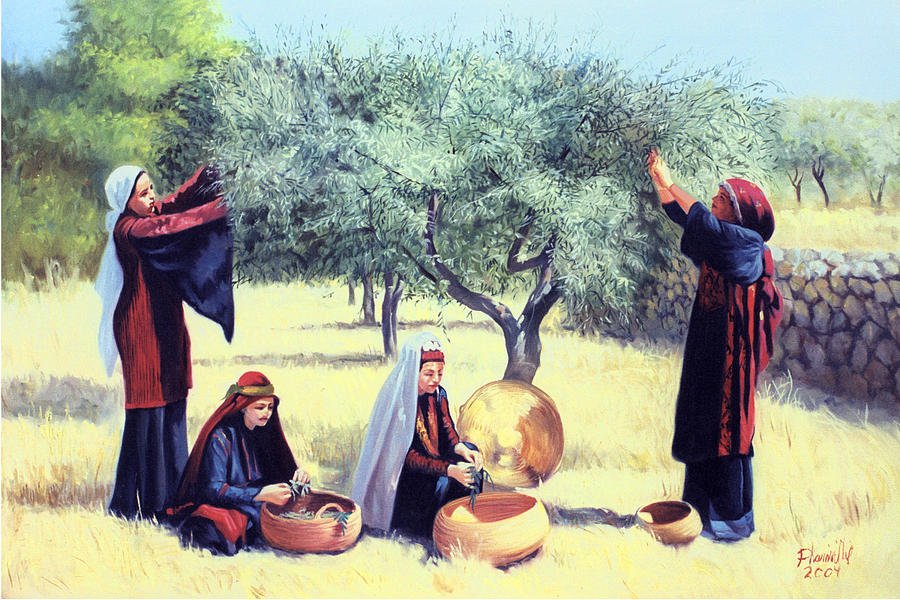Palestine and the Olive Tree
For decades, Palestinians have relied on symbolic articulations of nationhood to communicate their historic connection to the land of Palestine. The most prominent of these symbols has been the olive tree, symbolising both their rootedness in the land, as well as their resistance against all forms of colonialism which aim to diminish their claim to it. This article will uncover some reasons as to why it has been made it a target of attacks by the colonial regime, and what these have looked like in recent history.
Olive picking, painted by Damin Abdullah
During the ongoing occupation, erasure of Palestinian history has been one of the most persistent forms of Zionist colonial violence. As a result of this attempted erasure, Palestinians have relied on symbolic articulations of nationhood to communicate their historic connection to the land of Palestine. The most prominent of these symbols has been the olive tree, symbolising both their rootedness in the land, as well as their resistance against all forms of colonialism which aim to diminish their claim to it.
Given its importance, it is no wonder why this symbol of resistance has been under constant attack by the regime as in essence, its cultural and economic significance directly attacks the colonial workings of the Zionist regime, which has sought to divide, disunite and weaken the Palestinian population. It’s very existence reinforces their claim to the land, which in turn attacks the Zionist narrative that is built on erasure, making the symbol alone an enemy of the colonial entity. This article will uncover some reasons as to why it has been made a target of attacks by the colonial regime, and what these have looked like in recent history.
Symbolic significance:
Under colonial strategies of fragmentation which divide the colonised society, cultural symbols can play an important role in unifying the colonised under one emblematic sense of nationhood. In the case of Palestine, the Zionist regime has built its colonial structure off of fragmentation policies, which actively seek to prevent the collectivisation of the Palestinian experience. This method has taken many different forms throughout the history of colonial occupation; Palestinians are isolated in restricted areas, some are imprisoned, and others are expelled from the land entirely, losing their physical connection to their homeland.
These policies are enacted to weaken the Palestinian experience, and thus their ability to oppose the colonial structure as a powerful, united entity. In this context, cultural symbols allow Palestinians to unite under one sense of belonging and heritage, reviving the cultural memory of their historic claim to the land under increasing attempts aimed towards erasing it. These symbols contribute to the national consciousness of people living in divided societies, where there are limited means of expression.
The olive tree is an example of a symbol that rekindled this cultural memory at a time when the regime's fragmentation policies were in full force. Olive trees hold a lot of historical significance, as they date back to 8,000 BC, which Palestinians draw connections to to amplify their traditions and ancient presence in Palestine. [1]. Nasser Abufarha suggests that the olive tree gained its symbolic significance once the Liberation movement was crushed in the 80s, when the exiled Palestinian populations in Lebanon lost their strategic position in the struggle for Palestine, as they were pushed into further exile in Tunis and Yemen [2]. The struggle then shifted primarily onto those in the West Bank and Gaza, where the olive tree was already taking hold as a symbol of resistance and rootedness in the land.
Economic security
In addition to its symbolic significance, the olive tree provides Palestinian’s with economic security in the occupied Palestinian territories (oPt). In 2009, it was recorded that around 45% of land in the oPt was planted with olive trees [3], while the olive oil industry more generally provides ¼ of the gross agricultural income in the oPt, supporting the livelihood of approximately 100,000 families. [4]
In this way, it could be said that the olive trees’ economic significance contributes to its symbolic significance, as any acts surrounding it including the planting, harvesting and general tending to the olive tree, become politically charged acts, aimed at safeguarding the oPt’s prosperity against the colonial occupation's disruption.
Understanding the economic and cultural significance of the olive tree provides a useful backdrop to grasping the motivation behind the regime's frequent attacks, and why they have increased significantly in recent years.
Colonial sabotage and exploitation
1. Uprooting trees
The regime has employed multiple methods of disrupting the prosperity that the olive tree provides Palestinians, attacking it as both an economic resource, and a symbol of resistance. A mass uprooting of trees occurred in 2002, in order to create space for the construction of the Separation Barrier [5], a key tool for the continuation of colonial apartheid.
The uprooting of olive trees for the expansion of Zufin, a Jewish settlement in the Tulkarm district // Image: Braverman article
This move was justified by a need to promote national security. To quell the outrage caused by the uprooting, it was promised that these trees would be relocated and replanted in new locations once consent was provided by the owner. This however, proved futile, as most Palestinians have no access to any other land, and have instead been witness to the regime replanting the olive trees on ‘Israeli’ land [6]. Here, a key articulation of Palestinian identity, nationhood and livelihood is not only stripped from the owner, but appropriated by the regime under the guise of national security.
2. Settler attacks on the olive groves
This violence extends far beyond the state, through the IOF and settlers who frequently pillage and vandalise the olive groves, especially during harvest season. Together, they have destroyed more than 165,000 olive trees, which has led to an economic loss amounting to $50,849,265 [7].
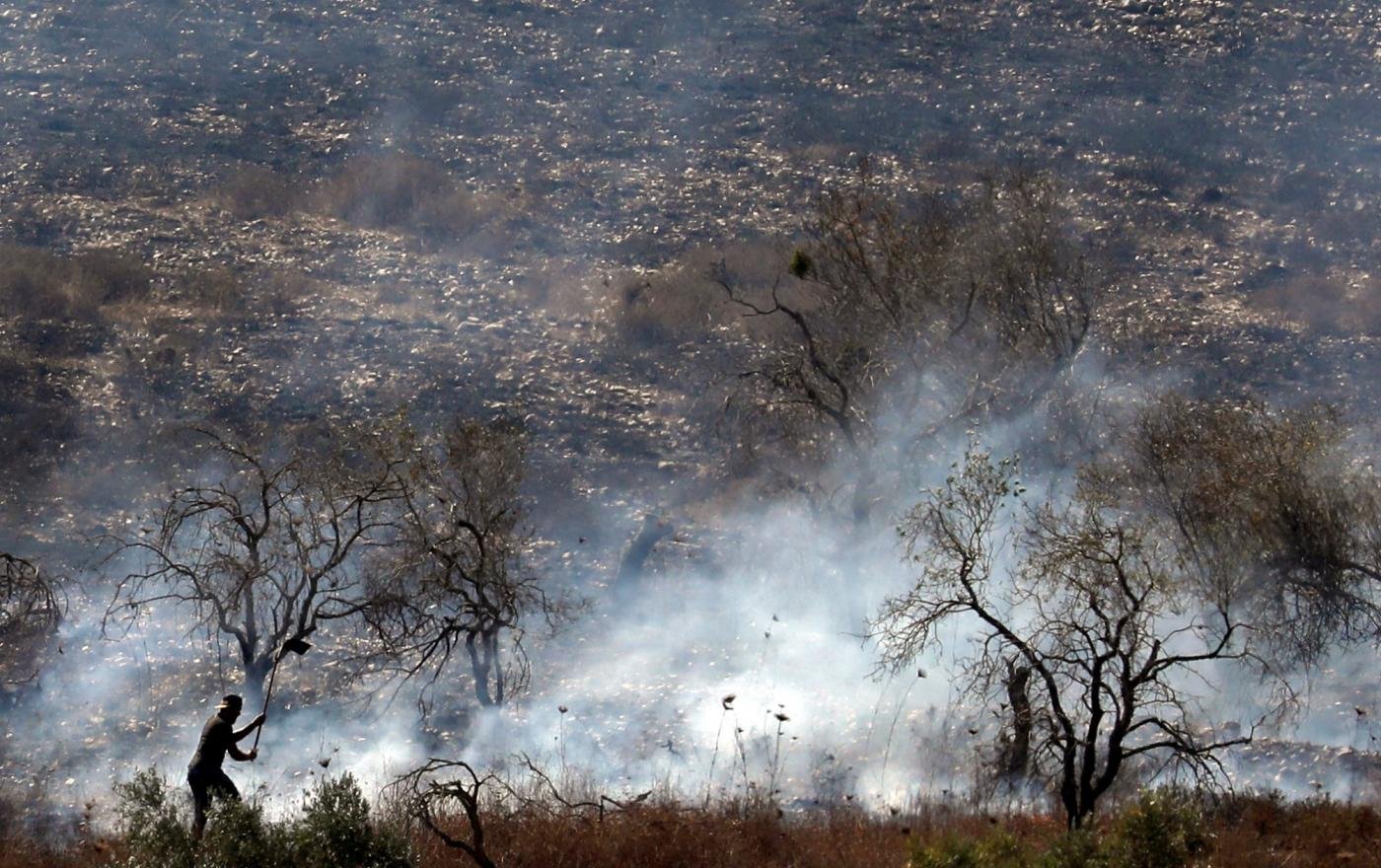
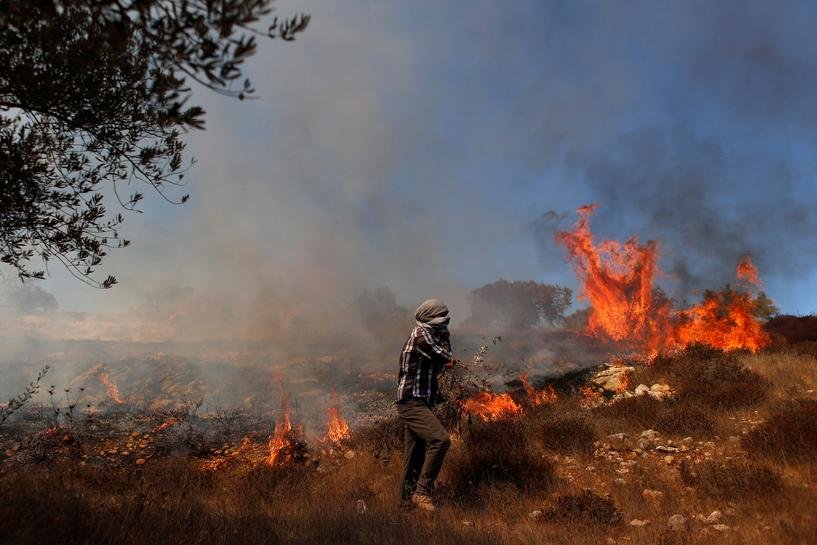
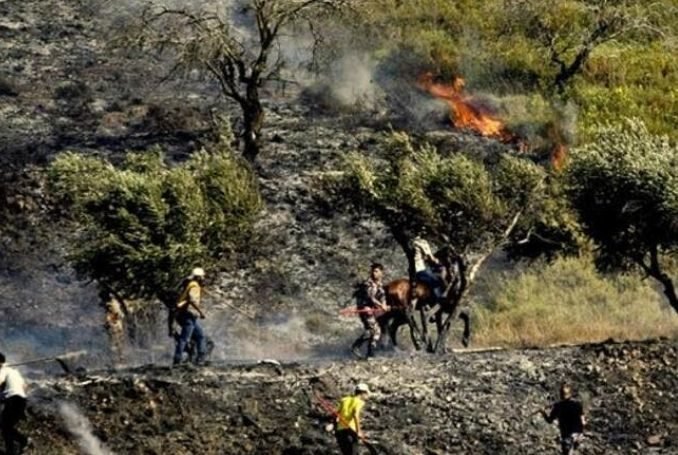
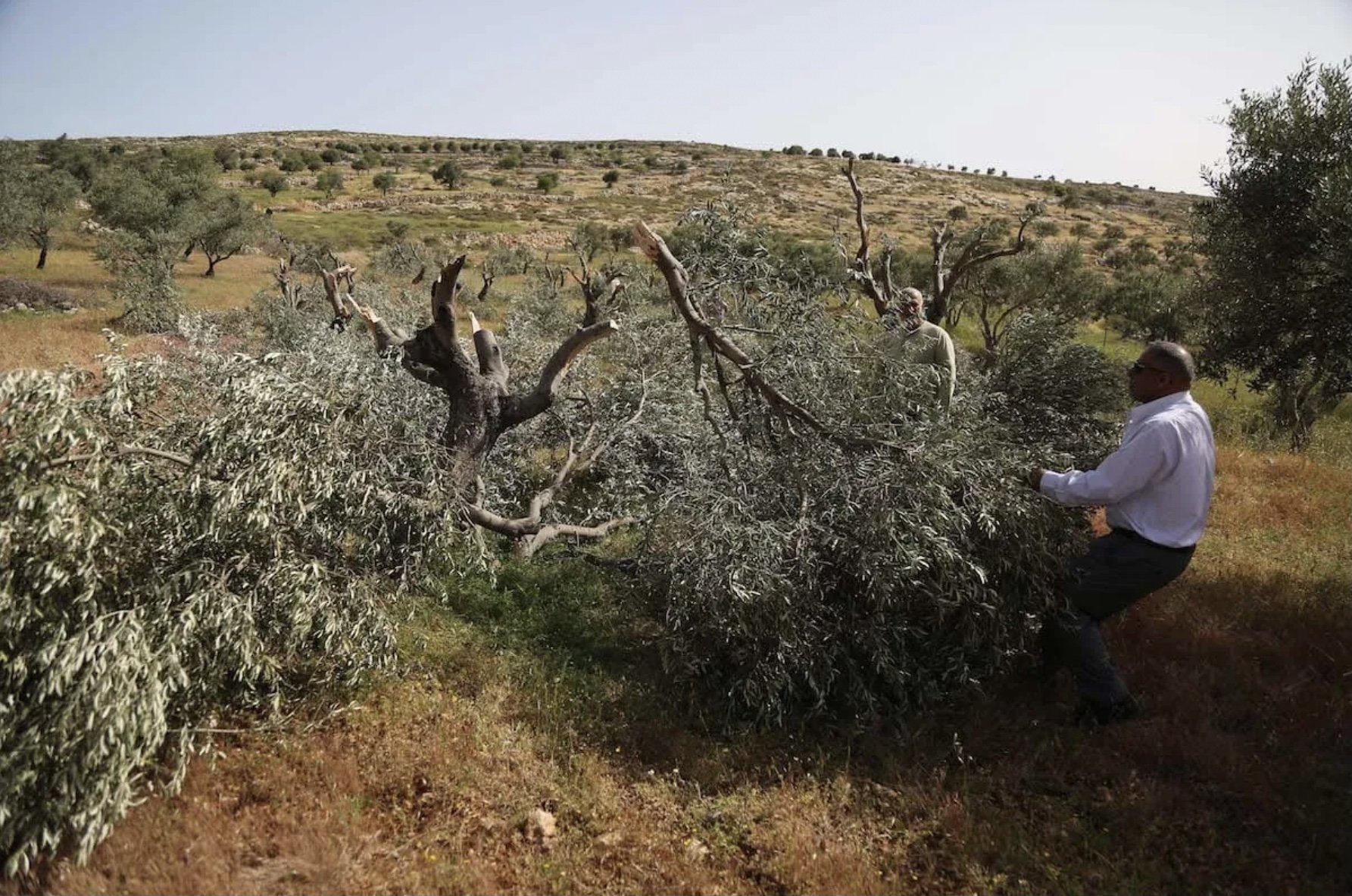
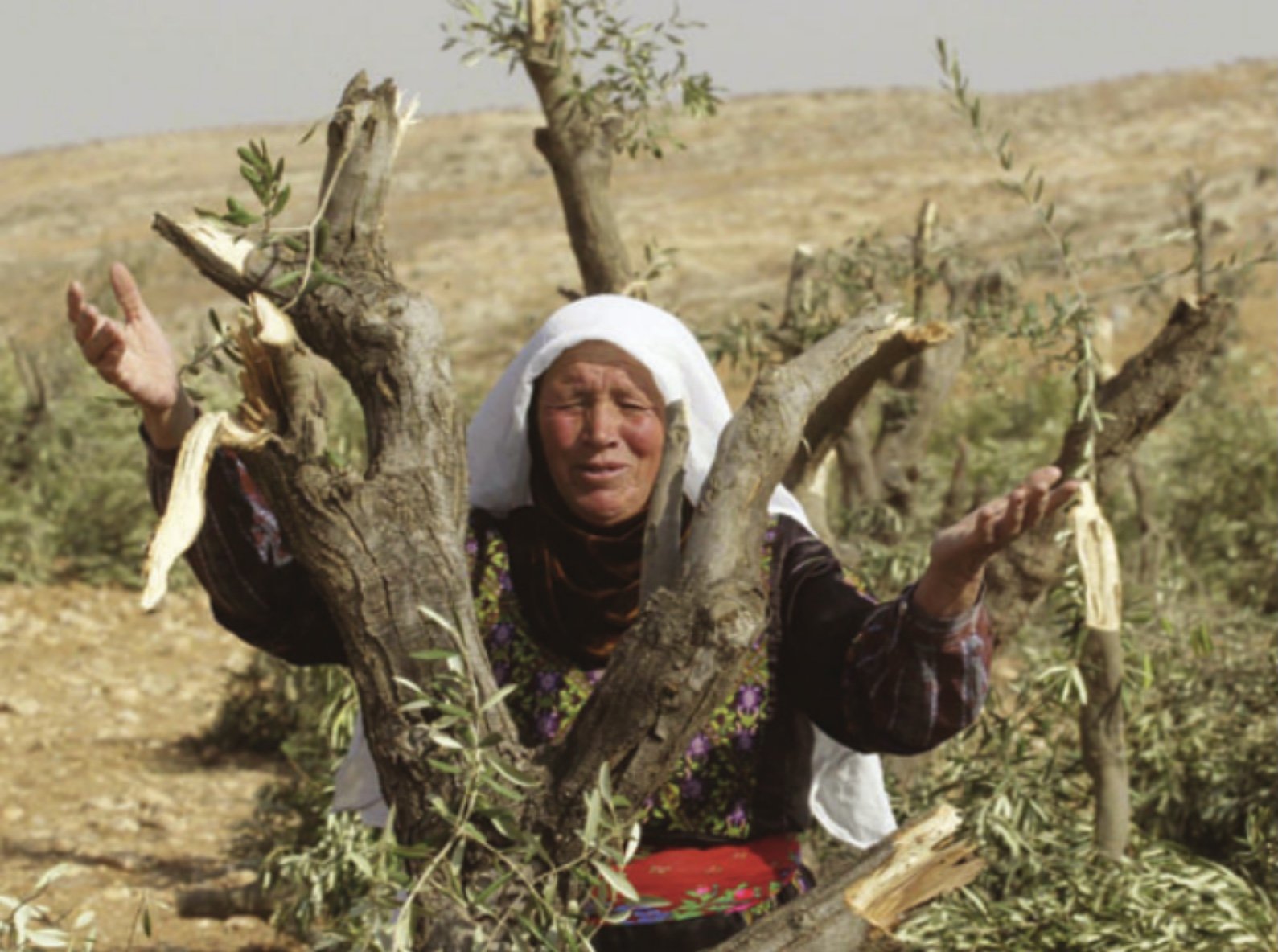
As recently as last Thursday, 9th December 2021, settlers from the illegal settlement of Mitzpe Yair, backed by IOF forces, chopped down 70 olive trees in the village of Masafer Yatta and led a herd of sheep onto a Palestinian farmers land to destroy its crops, leading to confrontations [8]. It’s been suggested that since the harvest season began on the 4th of October, this year alone 3,000 olive trees have either been damaged or had their harvest stolen [9].
3. Restrictions on social mobility: the permit and timetable system
Colonial sabotage and exploitation has taken on more discrete forms, such as through the permit and timetable system which was put in place for “olive protection,” but in reality has expanded the reach of colonial surveillance and restrictions on social mobility.
Both systems severely limited the economic prosperity for Palestinians in oPt, as they limit Palestinian access to land. At least 40,000 dunums of olive trees were declared military zones, forcing Palestinians to obtain permits that would give them access to their fields for a limited number of days [10].
In Samara, protection is only offered when military timetables are complied with, alienating “Palestinians from local time” by only allowing harvesters access to fields between specific dates that do not account for the time it takes to harvest [11].
Considering that colonised societies more generally are heavily reliant on agriculture as their main economic sector, the effects of Zionist domination have been severe; as stated by the PLO’s National Affairs Department, these expanding spatial restrictions have “provoked a sharp decrease in the agriculture sector's contribution to GDP in the occupied Palestinian territory, from 36% in 1970 to 9.5% in 2000. In 2019, it was less than 3%.” [12].
Here, under the guise of protection, the regime has expanded the reach of its surveillance apparatus, which constricts Palestinians’ sense of time and autonomy over their own land.
Conclusion:
Under the context of fragmentation policies which have sought to fragment and weaken the collective strength of the Palestinian experience, the olive tree acted as a uniting force which symbolically drew all Palestinians together under the same struggle, despite forceful attempts to divide them, which further inspired their narratives of resistance. Economically, the olive tree has brought with it an industry that has sustained the livelihoods of many in the oPt. This cultural and economic importance is only heightened by Zionist attacks, as this alone has given the olive tree another layer of symbolic meaning; under the context of colonial violence, everyday acts of planting, tending and harvesting the olive tree have become in essence, acts of resistance.
These examples of violence against the olive tree on both a societal and state level have highlighted a characteristic theme of the Zionist regime; there is no ‘national security’ or ‘Israeli’ state that does not involve the deliberate plundering of Palestinian resources, economy and culture. Their own colonial policies, including those undertaken to promote national security and so-called “olive protection,” prove that the two cannot find peace in co-existence; there can be no Zionist state alongside a Palestinian state, when the former necessitates full control of, and impediment to, the latter’s ability to not only flourish, but to simply exist.
The olive tree has provided Palestinians with a narrative of both heritage and resistance. It demands that attention be given to the Palestinian right to exist independent of their colonial occupiers, making it on its own a powerful symbol in opposition to the regime.
Sources Used:
[1] Land of symbols: cactus, poppies, orange, and the olive trees in Palestine, Nasser Abufarha, p.353
[2] Ibid, p.352
[3] Uprooting identities: The Regulation of Olive Trees in the Occupied West Bank, Irus Braverman, p.240
[4] Olive Harvest Fast Facts, The Question of Palestine, OCHA
[5] Braverman, p.240
[6] Ibid, p.249
[7] Israel's Hegemony Explained: The Case of Palestine’s Olive Harvest Season, PLO Negotiations Affairs Department (NAD)
[8] ‘Israeli settlers chop down 70 olive trees, let loose sheep to destroy Palestinian farm,’ Middle East Monitor
[9] Ibid
[10] NAD
[11] Braverman, p.257
[12] NAD
Necroviolence in Palestine
In light of the Zionist regime’s announcement of its plan to demolish part of the centuries old Al-Yusufiya cemetery for the construction of a national park, this article discusses the forms of necroviolence inflicted on Palestinians through the decades, exposing its effects and consequences on Palestinians long after death, when it is backdropped by colonial occupation.
Mother of Alaa Nababta clings to her sons grave at Al-Yusufia Cemetery, resisting the IOF’s forceful attempt to remove her // Source: Mostafa Al-Kharouf
The Zionist regime’s announcement of its plans to demolish the centuries old Al-Yusufiya cemetery for the construction of a national park sparked widespread public outrage last month.
However, it is important to understand that this act was not an isolated event, but rather one reflective of a pattern characteristic of colonial rule, whereby the colonised populations’ heritage, history, and identity are violated by the coloniser, sometimes long after death.
This article will draw on the framework of necroviolence to bring these patterns to light, and to further uncover the discriminatory ethos embedded deep within the Zionist regime’s character, which justifies the execution of these violent attacks against every aspect of Palestinian existence.
What is necroviolence?
The concept of necroviolence finds its origins in the theory of necropolitics first coined by Achille Mbembe, a political theorist. In his words, Necropolitics explains “the ways in which, in our contemporary world, weapons are deployed in the interest of maximally destroying persons and creating death-worlds, that is, new and unique forms of social existence in which vast populations are subjected to living conditions that confer upon them the status of the living dead.” [1]
In his book, Mbembe argued that the clearest example of the manifestation of necropower today is the Zionist colonial occupation of Palestine. From surveillance to outright apartheid, the regime exerts full control over the conditions in which Palestinians both live and die.
Necroviolence however, takes this theory one step further. Building off of Mbembe’s theory, Jason De Leon brought forward the concept of necroviolence which would take this theory beyond the boundaries of death. He defines it as:
“Violence performed and produced through the specific treatment of corpses that is perceived to be offensive, sacrilegious, or inhumane by the perpetrator, the victim (and her or his cultural group), or both.”
- Jason De Leon in The Land of Open Graves, p.69 [2]
His theory goes beyond how states assign different values to human life, to offer insight into what happens once this judgement results in the death of individuals from the ‘inferior’ community.
Necroviolence then, is the recognition that violence against a certain community can extend far beyond death, which allows us to draw out both the effects of this form of violence on the community that identify with the dead, as well as the characteristic condition of the perpetrator which justifies this corporeal mistreatment.
The Zionist regime’s use of necroviolence
1. ‘Ambiguous loss’; withholding Palestinian bodies
Since 1967, the Zionist regime, has been preventing Palestinian families from mourning their loved ones by withholding their bodies in freezers, [3] or the ‘cemetery of numbers’ (discussed below). This form of necroviolence, which imprisons the already dead, forces Palestinian bodies to exist in a state of absence; their location, status, and condition are often unknown for an indefinite period of time.
A mother stands at the empty grave of her son in the occupied West Bank. The regime has refused to hand over his body // Source: MEE, Shatha Hammad
This act in itself can be viewed as a form of collective punishment aimed at the families of the martyrs, who are forced to endure a great level of psychological pain in addition to grief over the loss of their loved ones. The colonial regime thus punishes families left behind for the mere existence of their martyrs, who represent Palestinian resistance as a whole.
“The erasure of a body… stunts the development of the social relationships that the living need in order to ‘make sense of the life and death of the deceased’ and negotiate (and renegotiate) the positions of the dead inside the living community.”
- Jason De Leon in The Land of Open Graves, p.71 [4]
Many families are then left in a state of what psychologist Pauline Boss calls 'ambiguous loss’; “a loss that remains unclear” [5], as their grieving process is forcefully halted by the regime's withholding of information which would allow families to carry out the cultural mourning process. By doing this, the Zionist regime alters the bereavement period by dictating when and how Palestinians should be mourned.
2. The cemeteries of numbers
‘Ambiguous loss’ can also be felt through the existence of the Cemetery of Numbers where mass graves of Palestinian martyrs are located, who are identified only by a numbered metal plate above their grave.
The Cemetery of Numbers // Source: The Palestine Chronicle
This marks an attack on the Palestinian experience, with the erasure of their names and the possibility of mourning, as well as a dehumanising attempt to erase individual identity by collectivising the Palestinian experience under nothing more than numbers.
Though in complete violation of human rights by international law, these bodies are kept as leverage for potential political negotiations with Hamas or the PA and as a deterrence from resistance to the occupation, further tormenting families who are left to campaign for the right to bury their loved ones days, months, and often years after their death. In 2019, the Israeli High Court approved the withholding of these bodies on the basis of state security, civil order, and the carrying out of political negotiations [6].
Here, we see the politicisation of Palestinian bodies, as they are used to maintain the colonial system, forcing martyrs to exist within the occupier-occupied dynamic long after death through the policing and dispossession of their bodies.
3. Demolition of historic gravesites
The Zionist regime has made the demolition of cemeteries a key arena for necroviolence to facilitate colonial expansion and historical erasure.
Mamilla cemetery - an ancient Muslim burial site located in Jerusalem, which dates back 1,400 years, has been one of the many burial sites under persistent attack by the Zionist regime. This cemetery in particular held the bodies of many of the early companions of the Prophet (pbuh), as well as Christians from the pre-Islamic era [7]. In the 80s, part of the cemetery was razed to build a municipal parking lot, while in 2004, it was announced that part of the cemetery would be demolished to create the Museum of Tolerance to commemorate the Jewish Shoah [8]. Bab Al-Rahmeh has faced the same fate, as large sections of the cemetery were levelled to build a park and hiking trail [9].
More recently, the Zionist regime announced its plans to demolish Al-Yusufiya cemetery - another burial site with great religious and historical significance. It was decided that a large portion of the cemetery would be razed in order to build a national park, which will open mid-2022. Public outrage soared last month, as images and videos circulated of Palestinian families clinging onto their loved ones' graves to protect them, while being confronted with stun grenades, beatings and arrests by the IOF [10].
A Palestinian shows the destruction of graves at Al-Yusufiya cemetery by the Jerusalem municipality and the Nature and Parks Authority // Source Ahmad Gharabli
As Jason De Leon suggests;
“The destruction of a corpse constitutes the most complex and durable form of necroviolence humans have yet invented. The lack of a body prevents a “proper” burial for the dead, but also allows the perpetrators of violence plausible deniability.”
- Jason De Leon in The Land of Open Graves, p.71 [11]
The regime has not only prevented the burial of Palestinian bodies, it has also gone to the extent of attacking the already buried, violating their bodies for further territorial expansion.
This also marks a step towards the complete erasure of the Palestinian experience, as many of these grave sites are centuries old, holding within them not only a history of Palestinian belonging, but one of resistance through the presence of martyrs who resisted decades of occupation.
The Zionist regime thus denies Palestinians agency in one of the few forms it has left to exercise; that is, the traces of their heritage, identity, and history on ground.
Conclusion
Here, we gain insight into the logic of Zionist colonialism, which necessitates full control over every aspect of the Palestinian individual, both in life and death; in all forms of existence.
This then, has grave consequences for the families of the martyrs, as the direct and indirect targets of most forms of necroviolence are the living community. The body is not treated as an individual. To the coloniser, the body is a national body representative of the enemy; the colonised group as a whole. It is they who have to endure punishment for their martyrs resistance, and often, just for their mere existence.
In this way, the regime’s exercise of necroviolence is a confirmation that Zionist colonialism continues long after death, through the dispossession, policing, and politicisation of Palestinian bodies, as well as territorial expansion through historical erasure. Erasing all traces of Palestinian culture, heritage, and identity works as an attack on the legitimacy of the Palestinian experience, allowing the regime what Leon called “plausible deniability,” and is therefore one of the key mechanisms with which the Zionist regime can continue its colonial rule.
Sources Used:
[1] Achille Mbembe, Necropolitics
[2] Jason De Leon, The Land of Open Graves, p.69
[3] Suhad Daher-Nashif, Colonial management of death: To be or not to be dead in Palestine
[4] Jason de Leon, p.71
[5] Ibid
[6] Lina Alsaafin, Israel slammed for ‘necroviolence’ on bodies of Palestinians
[7] Randa May Wahbe, The politics of karameh: Palestinian burial rites under the gun, Randa May Wahbe p.329
[8] Ibid
[9] Ibid
[10] Samah Dweik, Palestinians vow to defend graves in Jerusalem cemetery
[11] Jason De Leon, p.71
The Flawed Application of ‘Normalisation’ for Peace Building in Palestine
Amongst the media storm that followed the 11 day Israeli massacre carried out in Gaza this past May, calls for a peaceful solution to end the bloodshed have been heard louder than ever before. Built off of an ill-informed understanding of ‘normalisation', many such solutions have come and gone, and where applied, produced more disastrous consequences than they came to solve. So what exactly does this term ‘normalisation’ mean, and who does it serve?
Yasser Arafat and Yitzhak Rabin shake hands outside of the White House after agreement over the Oslo Accords (1993).
Amongst the media storm that followed the 11 day Israeli massacre carried out in Gaza this past May, calls for a peaceful solution to end the bloodshed have been heard louder than ever before. Built off of an ill-informed understanding of ‘normalisation', many such solutions have come and gone, and where applied, produced more disastrous consequences than they came to solve. So what exactly does this term ‘normalisation’ mean, and who does it serve?
To onlookers who have little to no knowledge on the origins of the state of Israel, and those who have internalised the western understanding of the Palestinian struggle, normalisation would seem to make sense. Calling for two rival states to view each other and their populations as equals, meaning to either shake hands under a new order inspired by an older, more palatable one, or to forget past strategies and proceed with a clean slate. This, they propose, creates a hopeful, promising future for both parties.
However, their suggestion highlights that those who advocate normalisation carry with them the preconceived notion that the two parties involved in a conflict are always equals in ability. Such a stance requires a complete oversight of history - however ugly it may be.
A glance at the historical record of the so-called ‘peace process’ in Palestine- where this term has been habitually misused - allows us to see the problems with seeking ‘normalisation’ in a situation wherein there has never existed a ‘normal’ bilateral relationship. In reality, the relationship is only a contemporary re-configuration of the relationship between the occupier and the occupied. It highlights how this very balance of power affects the terms of normalisation, often tipping it in favour of the more powerful faction.
The next section will develop this discussion.
Normalisation in perspective: a glance into the historical record
The Foundations of the Zionist Regime
If normalisation means the return to better relations, finding a point in history where relations have been satisfactory is a difficult task.
From its very inception, the Zionist state has built itself off the trampling of Palestinian rights. The Balfour Declarations which declared a national homeland for the Jewish people, did so without any Palestinian agreement, though they made up 90% of the population [1]. A series of policies seeking to make this ‘national homeland’ a reality by forcefully displacing Palestinian populations through land grabs and mass displacements, meant that Palestinians have only seen decades of turmoil since the birth of the Zionist regime. There has been no equality of status, nor forms of recompense for the above violations of international law. Thus, seeking to reinstate some form of return to an imagined past where relations were somewhat ‘better’’ is futile, as it never existed to begin with.
This history of violence, expulsion and oppression cannot be forgotten, as it is this history which continues to form the backdrop of any solution to the Palestinian occupation, as well as the Palestinian stance within negotiations. Attempting to deny or erase this reality, as has been done in most peace talks, has only exacerbated the apathy towards them.
The failure of the Oslo Accords
On the other hand, if normalisation means the turning of a new leaf and forgetting the history of Palestinian subjugation, we do not need to imagine what this might look like, since we have seen it in action through the outcomes of the Oslo Accords where the PLO was first recognised by Israel, and the Palestinian Authority first formed.
Under this so-called peace process, the West Bank (WB) was divided into areas A, making up 18%, Area B making up 22%, and Area C making up 60%, of which both areas A and C were supposed to be under full jurisdiction of the PA [2].
In reality though, none of this materialised, with Israel having full external security control over area A and full control of area C, including that of its economy, construction, and development [3], tripling the number of illegal settlements in the West Bank that were maintained by the same oppressive policies used in the years prior - the vast majority of which remain in area C.
In this way, a peace process said to normalise ties between Israel and Palestine, paving the way towards a two-state solution, ended with the expansion of settler colonialism and suffocation of the Palestinian liberation movement, highlighting one of the key failures of policies built off of a flawed application of normalisation. Any policy made in the name of normalisation thus far has tended towards the desires of the more powerful faction, creating no possibility for both parties to talk on equal terms; it is the occupier who has set the terms, and it is the occupier who has reaped its benefits.
American endorsement of the occupier’s status quo
America’s conceptual understanding of normalisation means the negotiation of peace in line with their allies; those who have sustained the balance of power with US help.
Not only was this evident in the Oslo Accords, but more recently in Trump's Middle East Plan which included the establishment of Jerusalem as the capital of Israel, the refusal of the right to return for Palestinians who were forcefully displaced, and the go ahead for Israeli annexation of the Jordan Valley [4] in Area C - a piece of fertile land which was found lucrative for Israeli companies seeking to exploit Palestinian resources, and home to around 65,000 Palestinians [5]. As of 2021, Biden is yet to make any significant changes to these policy implementations.
Normalisation requires an equal playing field for all parties involved; there can be no normalisation where there is no balance of power, especially when we are discussing it in relation to the hierarchical arrangement between occupier and occupied. Yet, as exemplified by these supposed peace deals and negotiations brokered by the West, the meaning and application of normalisation where there are uneven power dynamics is hijacked and gravely distorted by being made with the more powerful faction and its allies in mind.
Conclusion
As the historical record of the peace process in Palestine shows, built into the very essence of normalisation is the silent acceptance and continuation of the Palestinian occupation. This is because we are not using any universal definition of normalisation to integrate into policies, but one that exacerbates the power imbalance by putting the more powerful factions' desire for the status quo to be maintained at the forefront of any deal.
There are lessons to be learned from this history, all of which point to there being little hope for peace between Palestine and Israel when this very relationship is reflective of the colonial power imbalance produced by the occupier-occupied relationship. This is the very problem with solutions built off of this pacifist understanding of normalisation such as the so-called two-state solution, which does nothing to counter this imbalance of power.
Any attempt at ‘normalisation’ would necessitate the complete reintegration of displaced Palestinian populations into their land, governmental control placed back into their hands, and a complete overhaul of the settler colonial system which was imposed on Palestine in 1917. Only once this is achieved will there be any justice done to the kind of normalisation we should aspire to; one that doesn't ignore or minimise the consequences of settler-colonialism, but seeks to entirely collapse this system of oppression.
Sourced Used:
[1] Illan Pappe, ‘The Palestine peace process: unlearned lessons of history'- https://www.historyandpolicy.org/policy-papers/papers/the-palestine-peace-process-unlearned-lessons-of-history
[2] Al Jazeera, Palestine Remix, https://interactive.aljazeera.com/aje/palestineremix/the-price-of-oslo.html#/14
[3] Al Jazeera, ‘What are areas A, B, and C of the occupied West Bank?’ - https://www.aljazeera.com/news/2019/9/11/what-are-areas-a-b-and-c-of-the-occupied-west-bank
[4] Oliver Holmes, et al, ‘Trump unveils Middle East peace plan with no Palestinian support,’ https://www.theguardian.com/world/2020/jan/28/donald-trump-middle-east-peace-plan-israel-netanyahu-palestinians
[5] Ian Black, “This ‘deal of the century’ for the Middle East will be just another bleak milestone,” https://www.theguardian.com/commentisfree/2020/jan/30/donald-trump-israel-palestinians-middle-east
[6] Noam Chomsky & Ilan Pappe, On Palestine
